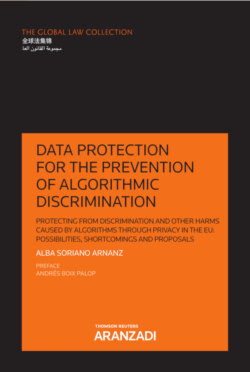Читать книгу Data protection for the prevention of algorithmic discrimination - Alba Soriano Arnanz - Страница 14
На сайте Литреса книга снята с продажи.
2.3. Algorithms and models
ОглавлениеThroughout the book, automated decision-making systems will be referred to in many instances as machine learning models and algorithms. As O’Neil puts it, models are “nothing more than an abstract representation of some process”.68 An algorithm is the list of instructions for analysing the data in order to provide the user with a certain answer or result given the available information or, in other words, a software code that processes a limited amount of instructions.69 Machine learning models and algorithms are “pattern recognition tools”70 which are trained with and use data mining and machine learning tools in order to extract or predict information regarding a certain phenomenon.
In supervised learning, algorithms (lists of instructions) are trained by being “punished” or “rewarded” depending on how accurate their predictions for the training data are,71 thus refining their interpretative and predictive capabilities. The algorithm will try different predictive rules (lists of instructions), finally choosing one that, according to the information the algorithm is provided, yields the most accurate predictive results for the historical data.72
For example, if the algorithm is being trained to distinguish between numbers when they are hand-written, it will be fed correctly labelled images of numbers so that it knows when it is making errors.73 Once it has been trained on historical data, it generates a learning tool that will be the final product used by organisations in order to feed it new data that it will process and produce results on.74 What generally results from this process is a model, an automated decision-making system that represents real life decision-making processes. The model will be the final tool that is deployed in order to make real decisions.
Models can be created without using algorithms and algorithms can be completely abstract and not be used to model anything. However, given the fact that this book focuses on automated decision-making, that is, using these technologies to model human decision-making, the systems analysed contain algorithms as sets of instructions which provide information regarding the way in which the decision-making model must behave.
If a model is designed to predict who will default a mortgage payment, during the training process, the technologies used to analyse the training data might have discovered that unemployed people with more than one child under the age of fifteen are more likely to default on loan payments. This is a rule that the deployed model will use when it is fed data on new subjects to determine whether they will default. Therefore, during training, learning techniques are used to find the relevant relationships between the data that will then serve as rules or instructions for when the model is processing real-world data.75
The objective of this section has been to draw a very general picture of the amount of information that these systems can process and generate and the degree of autonomy and complexity they can achieve so as to illustrate how the difficulty of understanding and controlling these systems (which clearly go beyond simply cross-referencing information in two databases) generates the need for new regulatory instruments that specifically address algorithmic decision-making.
